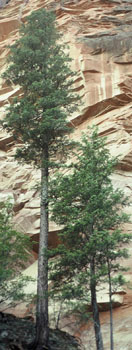Weeds
Weeds are plants growing where humans do not want them. Their undesirable qualities are varied: they deprive crop plants of sunlight, water and mineral nutrients; can be poisonous to humans or domestic animals; act as hosts for plant diseases, destructive insects and other pests; contaminate milk or other agricultural products; bear spines or thorns; cause allergies such as hay fever. Weeds are found not just in agricultural areas but also in forests, lakes, recreational areas, roadsides and all other sites of human activity.
Weeds belong to virtually all plant families. They include algae, primitive vascular plants (eg, field horsetail, Equisetum arvense, and bracken fern, Pteridium aquilinum), low creeping annuals (eg, purslane, Portulaca oleracea), tall coarse herbs (eg, lamb's-quarters, Chenopodium album), vines (eg, field bindweed, Convolvulus arvensis), parasites (eg, dodder, Cuscuta), shrubs (eg, common barberry, Berberis vulgaris) and trees (eg, Manitoba maple, Acer negundo). Weeds have the following attributes: rank, vigorous growth; rapid maturation; vigorous regrowth after damage; abundant seed production; intermittent germination of seeds over many years; underground spread of roots or rhizomes. No single weed excels in all these attributes, but all have several.
In agriculture, weeds are estimated to cause more losses than destructive insects and plant diseases combined. Until the mid-1950s, the principal means of control was cultivation. Increasingly sophisticated cultivators, first horse drawn and then tractor drawn, made the task easier, but much of the labour involved in crop production was for weed control. The development, early in the century, of seed-cleaning plants where weed contaminants were removed from crop seeds, was a major step in weed control.
The Canada Seeds Act classifies crop seeds according to weed seed content. Grain exports must have less than a specified minimum content of weed seeds, and seeds of species designated as noxious are subject to the most stringent rules.
Chemical Control of Weeds
Chemical control of weeds began around 1950 with widespread use of 2,4-D. At present in Canada, more than 100 chemicals are licensed for sale as herbicides. Millions of dollars are spent on them annually, but this sum is less than would otherwise be spent on weed removal from fields and harvested crops. Federal and provincial legislation is designed to ensure that herbicides are marketed and applied safely. Modern farmers attempt integrated weed control by a combination of chemical means and tillage. The advent of chemical herbicides has modified, but not eliminated, the weed problem.
Across the prairies, infestations of weeds (eg, wild mustard, Sinapis arvensis) have been reduced, but species tolerant of common herbicides (eg, green foxtail, Setaria viridis) have greatly increased. Similar shifts in weed populations involving various species have occurred in other agricultural regions. In the 1970s, herbicide-resistant forms of several common weeds began to appear. Lamb's-quarters, common groundsel (Senecio vulgaris) and redroot pigweed (Amaranthus retroflexus) all now have forms that are resistant to the popular triazine herbicides.
Biological Control of Weeds
Biological control of weeds usually involves the introduction of an insect or a fungus species to control an introduced weed, and has been attempted in many parts of Canada. In the interior of BC, Saint-John's-wort (Hypericum perforatum) has been controlled by beetles. In the same area, the reduction of knapweeds (Centaurea) by both insects and fungi is being tried. The targets are usually perennial species in uncultivated land.
Canada's largest and most important agricultural area encompasses the southern part of the Prairie provinces. In cultivated land in Saskatchewan and Manitoba, the most abundant weed (in a 1976-79 survey) was green foxtail; second and third were wild oats (Avena fatua) and wild buckwheat (Polygonum convolvulus). Other common weeds of Canadian agricultural land are dandelion (Taraxacum officinale), Canada thistle (Cirsium arvense), common milkweed (Asclepias syriaca), leafy spurge (Euphorbia esula), pigweeds (Amaranthus), sow thistles (Sonchus) and ragweeds (Ambrosia).
Weeds of other habitats include poison ivy (Rhus radicans) in woodlands, and common plantain (Plantago major) and white clover (Trifolium repens) in lawns. The introduced submerged aquatic weed, Eurasian water milfoil (Myriophyllum spicatum), poses a multifaceted problem in lakes, canals and streams across southern Canada, much as our native elodea (Elodea canadensis) did in Europe in the 1800s. Weeds may have desirable qualities. White clover is a useful pasture plant. Sweet clovers (Melilotus) are dangerous roadside weeds because they attract bees near passing cars and obscure road signs, but they are valuable short-term hay and pasture plants and are a source of honey. See also insects, beneficial; insect pests; pesticides.

 Share on Facebook
Share on Facebook Share on X
Share on X Share by Email
Share by Email Share on Google Classroom
Share on Google Classroom



